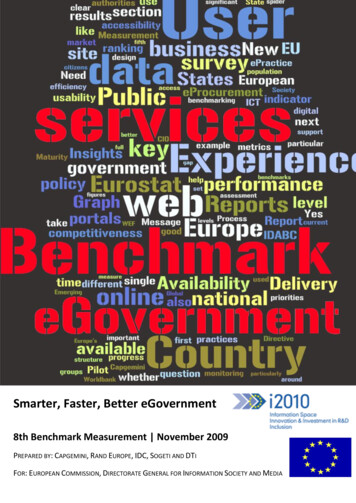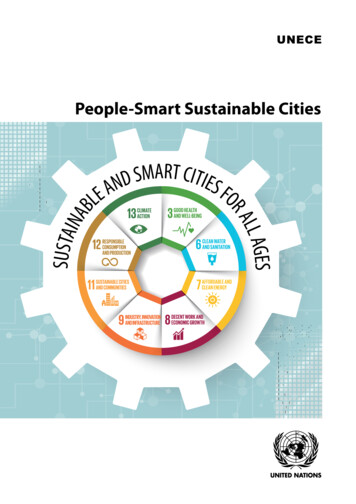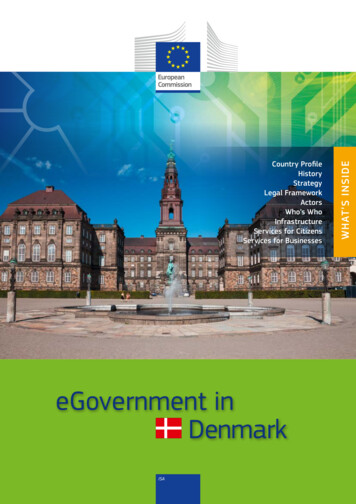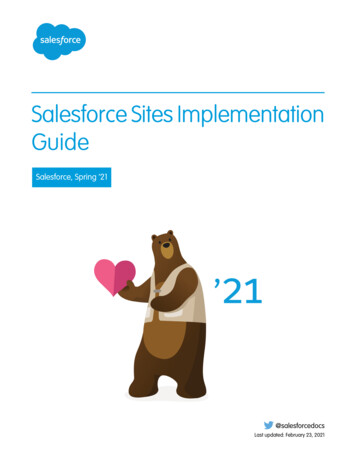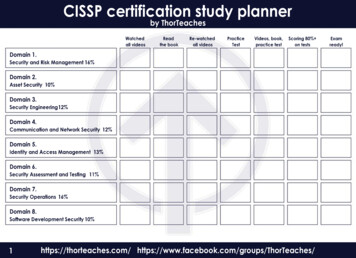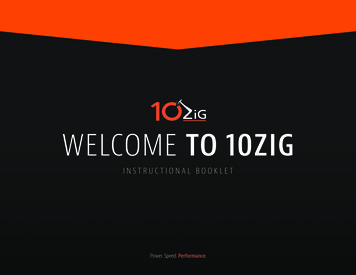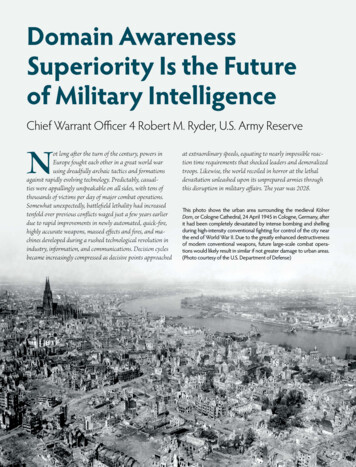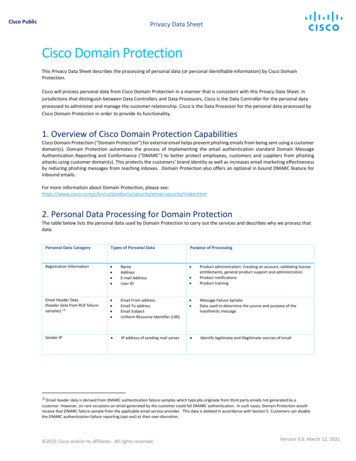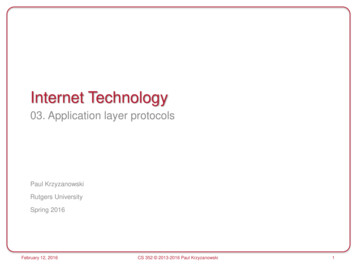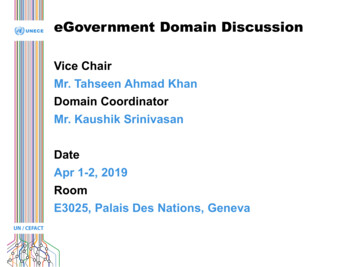
Transcription
eGovernment Domain DiscussionVice ChairMr. Tahseen Ahmad KhanDomain CoordinatorMr. Kaushik SrinivasanDateApr 1-2, 2019RoomE3025, Palais Des Nations, Geneva
Agenda – Apr 1, 2019TimeTopicSpeaker andComments11.00 – 12.30eGov Domain – Update- Mutual Recognition- Blockchain Project- Advisory Group on EmergingTechnologiesTahseen Khan, ViceChairKaushik Srinivasan,Domain CoordinatorVirginia Cram Martos –Project Leader,Blockchain12.30 – 14.00Lunch14.00 – 15.30Discussion on proposed project forcross border distributed ledger forexchanging digital preferentialcertificate of origin15.30 – 16.00Coffee Break16.00 – 17.30Discussion on proposed project ondigital ID for TradeSteve Capell, ExpertMemberVijay Kumar/ChrisGough, Expert Member
Agenda – Apr 2, 2019TimeTopicSpeaker andComments9.00 – 10.30Discussion on emerging trends intechnology such as QuantumComputing and their role in tradefacilitationWorking Group10.30 – 11.00Coffee Break11.00 – 12.30ePayment Systems and their rolein enabling financial inclusionWorking GroupArtificial Intelligence12.30 – 14.00Lunch14.00 – 15.30Data Retention and Time Stamping15.30 – 16.00Coffee Break16.00 – 17.00IoT Whitepaper ProjectVirginia Cram Martos,Project Leader
eGovernment Domain Update –Action Items from Hangzhou Forum
Hangzhou Forum – Action Items At the last UN/CEFACT forum at Hangzhou, keycybersecurity related topics pertaining to global tradewere discussed. These included International Convention on Mutual Recognition Internet of Things Digital ID for Trade Data Retention/Time Stamping Artificial Intelligence for Trade Facilitation GDPR and its implications
Hangzhou Forum – Action Items The Working Group felt that we should continue to pursue work inthe following areas Work with UNCITRAL to understand how we can complementeach other’s work on mutual recognition Begin work on IoT Whitepaper Project (to start after Blockchainproject) and study emerging technologies such as ArtificialIntelligence in the context of IoT Given that Digital ID systems are now increasingly adopted, anew project on Digital ID for Trade be launched with focus on Studying existing systems such as GLEIF, ID systems inAustralia, Germany, India, Italy, One World Identity(Blockchain) and their characteristics Working with UN teams who are responsible for Identity tounderstand implementations Providing guidance material on adopting digital ID fortrade facilitation Launch a project on best practices for Data Retention/TimeStamping to study existing work done by International LibrarianAssociation, International Council on Archives
Trusted Transboundary ElectronicInteraction/Mutual Recognition
Mutual Recognition International Convention - Trusted Trans-boundary electronicinteraction/Mutual Recognition mechanism This project was taken up to develop a framework conventionwhich is intergovernmental Whitepaper prepared and finalized highlighting need forframework convention Link to white paper Need for Mutual Recognition also highlighted in the BlockchainWhitepaper During the last forum, it was felt that we need to study whatUNCITRAL has done in this context and align our workprogramme accordingly
Mutual Recognition International Convention - Trusted Trans-boundary electronicinteraction/Mutual Recognition mechanism UNCITRAL has been doing work related to “Legal Issues relatedto Identity Management and Trust Services” Link to document (UNCITRAL Document No A/CN.9/WG.IV/WP.153) Scope of work includes prepararation of text aimed atfacilitating cross-border recognition of Identity Management(IdM) and Trust Services Within the scope of Identity Management, the document highlightsthree broad approaches for mutual recognition of Identity schemes Ex ante legal recognition – Centrally managed evaluation andlicensing institutional mechanism to assess IdM schemes andrecognize them Ex Post Legal recognition – Mechanism that generally allowsexchanges of data and assesses suitability for use of IdMschemes and trust services only in the event of dispute andon the basis of predetermined criteria Mapping based legal recognition – Mapping IdM systemsbased on a common template.
Mutual Recognition International Convention - Trusted Trans-boundary electronicinteraction/Mutual Recognition mechanism In the context of Trust Services, article 12 MLES, based on a“susbtative equivalence” approach requires that no discriminationshould arise from the foreign elements on an electronic signature Other mechanisms of cross border recognition relies on bi-lateralor multi-lateral agreements and usage of cross-recognition orcross-certification schemes (as in the case of PKI) While mechanisms for mutual recognition exist, practicalimplementations have been limited
Mutual Recognition Some of the implementations include eIDAS regulation Provides a cross-border common legal framework within theEuropean Union for recognition of electronic ID andconsistent recognition of trust services Article 14 provides for recognition of trust service providerthat are outside the EU PAA PKI framework Alliance of paperless trade service providers in Asia Driven based on mutual recognition framework thatestablishes a comparable level of trustworthiness Eurasian Economic Commission Described in the provision on exchange of electronicdocuments at cross border interaction of public authorities ofEurasian Economic Union member states among themselves
Mutual Recognition Given that Mutual Recognition is key to achieving cross borderpaperless trade, working group to discuss the role UN/CEFACTcould play in Defining key components for establishing and operatingcross border mutual recognition Highlighting best practices in existing cross border mutualrecognition arrangements Developing guidance material for reliably establishing“substantive equivalence” in cross border IdentityManagement and Trust Services schemes
Blockchain Whitepaper Project
Blockchain Whitepaper Project The Blockchain Whitepaper project is nearing completion Most of the sections and associated edited and completewhich has been submitted to Secretariat for preparation to besubmitted to Plenary Sections on Financial Services, Government and Healthcare tobe edited by the time of the Forum and some of the casestudies require more time (as they require external input to befinalized) These sections and additional case studies will be submitted tothe Bureau for approval once they are edited
Advisory Group – AdvancedTechnologies Based on discussions during eGoverment Domain and BlockchainWhitepaper project team meeting at the UN/CEFACT forum in October2018, the establishment of an advisory group was proposed to theBureau in order to advise and support the UNECE secretariat andUN/CEFACT on advanced technologies in trade facilitation andelectronic business The technologies in question include Blockchain, Internet of Things(IoT) and Artificial Intelligence (AI) – the most recent areas ofdevelopment in the international supply chain For more information about the mandate and terms of reference of theadvisory group on advanced technologies in trade and logistics, pleaserefer the document (ECE/TRADE/C/CEFACT/2019/22/Rev.1) availableat the link here
Cross border exchange of digitalpreferential Certificate of Origin
Cross-border distributed ledger forexchanging digital preferential COO(inter customs ledger) A preferential Certificate of Origin (CoO) is a document issued by theexporting customs authority that asserts that the goods in a specificshipment comply with the terms of a free trade agreement (FTA) At present, preferential CoO are paper documents that are slow andexpensive to produce Electronically verifiable digital origin evidence will help streamline theprocess and reduce costs at the border The challenges associated with exchanging a digital CoO looked like aproblem that Blockchain could solve A project has been proposed to tackle this challenge throughBlockchain Project Lead/Co-Leads – Steve Capell, Wang Xiang/HardeepBatra Countries on-board for the project – Australia, China and India Deliverables include BRS/RSM on preferential CoO Guidance material on exchange of documents throughBlockchain Reference implementation of the platform
Cross-border distributed ledger forexchanging digital preferential COO(inter customs ledger) Benefits of the inter customs ledger include Maximises autonomy Each jurisdiction manages their own community Transactions are auditable and this drives trust CoO can be transferred and acquitted Localised languages National hosting supports data sovereignty No central funding needed National or provincial implementation feasible Scalable to any bi-lateral or multi-lateral trade Scalable to other certificate types Steve Capell will make a presentation highlighting scope anddeliverables of the project
Proposed Project on Digital ID forTrade
Digital ID for Trade Digital ID systems which allow an entity to prove theiridentity online are opening new possibilities for crossborder trade by eliminating trade barriers and paperwork Many forms of ID exist today which are largely physicaland do not provide level of trust required for online trade. Digital ID schemes that are well implemented Allow users to establish their identity as part of anonline transaction Enable electronic Notaries or Trusted Authorities toverify this identity Provide confidence to relying parties that couldinclude both consumers and businesses Ensure safe access and transfer of online information Facilitate compliance with required regulatory regimes
Digital ID for Trade The practices vary from every country to country, andmay have several local jurisdictional IDs. There are also recognized private identity systems, or thosewhich are independently functioning as a non-profit andaccepted in a larger region. There are also many forms of ID exist today which are largelyphysical and do not provide level of trust required for onlinetrade. A project has been proposed to study existing digital IDsystems in the context of trade facilitation Proposed Project Lead/Co-Lead – Vijay Kumar, Chris Gough Scope of work includes studying and presenting bestpractices from existing digital ID systems that can act asa guide for future implementation
Digital ID for Trade Case Studies Global Legal Entity Identifier Foundation Supports the implementation of Legal Entity Identifierstandard for entities dealing with financial institutions eIDAS Regulation EU regulation for electronic identification and trust servicesfor electronic transactions in the European Union Separate chapters for Electronic Identification and TrustServices While Trust Services are mutually recognized across EU, eIDschemes require notification by Countries for mutualrecognition AADHAAR programme - India World’s largest biometric identity program using a centralIdentity provider operated by the Government that has beeneffective at enabling financial inclusion
Digital ID for Trade Case Studies E-Residency program by Estonia Allows non-Estonian citizens to get a digital ID which allowsthem to use Estonian public and private services Operate a platform called X-Roads that createsinteroperability between different databases Australia DigitalID program Ability to authenticate using a digital ID for availing onlineservices
Digital ID for Trade India Stack using AADHAARConsent LayerModern privacy data sharingframeworkCashless LayerReal time electronicpayment systems at low costPaperless LayerSupporting QualifiedeSignatures at low costPresenceless LayerUnique digital biometricidentity and authenticationfor over a billion users
Digital ID for Trade Estonia Information System – X-Road
Digital ID for Trade Case Studies Gov.UK Verify Public private programme that allows UK citizens to accessgovernment services online through authentication via identityproviders DigiID - Netherlands Central authentication system for Dutch residents who areaccessing government services online Sweden BankID A public private service that provides citizens access to 300public and private services using an eID system where thedigital identities are issued by Banks and Telco
Digital ID for Trade Proposed focus areas Identity attributes Standards for defining Identifier (ISO 6523, PEPPOL,OASIS) Scope of identification (Individuals, Businesses,Relationships between the two), Assets such asShipments, Consignments Standardization of ID Verification procedures andmethodologies Federated vs Unified Identity Schemes Data exchange formats Authentication, Authorization, Validation User Experience Cross border regulatory compliance Mutual recognition issues Cyber Security Issues Use Cases
Digital ID for Trade Proposed high level project deliverables Green paper on case studies of existing digital IDsystems and their implementation methodologies in thecontext of cross border paperless trade Guidance material for developing digital ID systems tofacilitate cross border paperless trade Working group to discuss the deliverables and come up withnext steps
Emerging Trends in technology andtheir role in trade facilitation
Emerging Trends in technology Gartner’s top trends in technology that are likely to have a major impactinclude Quantum Computing, 5G, Augmented Reality, AutonomousThings -top-10strategic-technology-trends-for-2019/ These trends are likely to have a major direct impact on tradefacilitation Cyber security will be reshaped as a result of Quantum computing 5G will redefine communications and allow the use of IoT ineveryday life Autonomous things with Artificial Intelligence could be a gamechanger in logistics, transportation and other sectors
Emerging Trends in technology Introduction video on Quantum Computing https://www.youtube.com/watch?v WVv5OAR4Nik Mobility in the age of Quantum Computing Global logistics will become a USD 15.5 trillion market Each year, 17 million containers are moved, 70 mn cars aremanufactured The scale and number of factors influencing a typical logisticsoperation are too many This results in many problems such as delays, lost revenue andsunk costs
Emerging Trends in technology Key challenges in logistics Route Planning Traveling Salesman problem (shortest time and cheapest cost forroute across N cities where each city must be visited once) Flight scheduling Traffic decongestion/flow optimization These are classical optimization problems which is difficult to solveusing a classical machine Quantum computers can be used to effectively solve complex big dataproblems in logistics
Emerging Trends in technology Impact of 5G in Supply Chain and Logistics Supply Chain involves a lot of moving parts and goods usuallychange hands multiple times during transit Keeping track of responsibility, ownership and insurance is animportant challenge that is currently tackled manually With 5G networks, goods can be fitted with 5G connected sensorswhich can transmit item’s location, temperature, humidity etcautomatically as often as required in a reliable manner Other use cases for 5G networks Transportation – 5G could allow enhanced vehicle to vehiclecommunication which could be crucial to safety in the world ofdriverless vehicles Manufacturing – ability to control and monitor productionoperations in « smart factories » that employ robots Education – 5G will pave the way for better augmented reality andvirtual reality experiences which can provide immersiveeducational experiences
Emerging Trends in technology Autonomous Things Video of autonomous robots based Warehouse https://www.youtube.com/watch?v 4DKrcpa8Z E A framework for assessing autonomous things based on Gartnerresearch (link here) could include Understanding the type Robotics, Vehicles, Drones, Appliances, Agents Applicability to environments Sea, Air, Land or Digital Evaluating level of capability, coordination and intelligence
Emerging Trends in technology As per Gartner research (link here)In order to evaluate the capability,coordination and intelligence, the following aspects may be looked into Capability Human Assisted Partial Automation Conditional Automation High Automation Full Autonomy Coordination Isolated Independent Connected Collaborative Intelligence Dumb and Static Semi-start and dynamic Individually Smart and Dynamic Collective smart with dynamic hive interation
Emerging Trends in technology Given the convergence of physical, virtual and intelligent world, it is agreat opportunity for working group to Discuss the impact of these trends on supply chain and globaltrade Assess the role UN/CEFACT standards could have in furtheringuse of such technology Evaluate if further work needs to be undertaken to study thesetechnologies
ePayment Systems
ePayment Systems Innovation in payment systems is critical in enabling financial inclusion Some of the key aspects in enabling financial inclusion (as published inWorld Bank’s draft on Payment Aspects of Financial Inclusion are Legal and Regulatory Frameworks Financial and ICT infrastructure Cost effective payment product design Omni-channel access points Promoting Financial Literacy Large volume, recurrent payment systems Today’s payment systems make use of intermediaries to routepayments. This makes cross border payments More expensive Subject to additional counter party and settlement risk Time delays to tation/payment-aspects-financial-inclusion
ePayment Systems Some of the innovations in ePayment systems that enabled cheaperand faster payments include Peer to Peer transactions Distributed Ledger based remittances Mobile wallets Near Field Communications Convergence of payment and identity systems
ePayment Systems Case Study – DLT based remittances - Ripple How ripple works? Link to video Ripple enables peer-peer server architecture to move moneybetween two parties using a set of trusted gateways Uses a native currency called XRP which provides liquidity forconverting from one currency to another Case Study – Peer to Peer Payments - Singapore Introduced a platform called PayNow that enables instant peerpeer transfer between customers of two participating banks byentering a mobile or personal identifiable number In 2018, PayNow Corporate was launched to allow businesses topay and recieve funds instantaneously Launched SGQR which combined multiple QR codes into a singleSGQR code Link to video
ePayment Systems Working group to discuss and evaluate if further work needs to bedone in this area to support trade facilitation
Artificial Intelligence in TradeFacilitation
Artificial Intelligence in TradeFacilitation Artificial Intelligence for Trade Facilitation Cross-border trade results in huge volume of structured andunstructured data as part of the buy-ship-pay process Manual processes and analysis of data result in huge turn aroundtimes. Key areas include Trade Negotitations Trade Operations (customs, supply chain) Trade transactions (letters of credit, trade finance) Data driven decision making using Artificial Intelligence andMachine Learning can significantly speed up trade processes withreduced errors These could include Statistical and Predictive Models For forecasting demand, fraud detection etc Natural Language Processing Mining text data (invoices, payments etc) Computer Vision Running analytics on images, videos
Artificial Intelligence in TradeFacilitation Evolution of Artificial IntelligenceSource - eeplearning-ai/
Artificial Intelligence in TradeFacilitation Deep Learning Systems make use of neural networks which maps setof relationships between input and output similar to how a human brainworks Deep learning systems continuously learn and adjust learning modelsto form new insights
Artificial Intelligence in TradeFacilitation Artificial Intelligence and IoT When combined with other systems such as IoT and Blockchain,Artificial Intelligence systems can be powerful in facilitating crossborder trade An example of using AI and IoT in logistics Link to video - Toyota Link to video – Boston Dynamics
Artificial Intelligence in TradeFacilitation Points to discuss Any other implementation examples of use of AI in TradeFacilitation How easy is it to build sustainable AI/Deep Learning solutions forobjects such as Food? Working group to debate this topic and discuss next steps
Data Retention and Timestamping
Data Retention According to IDC, we will create 1800 new exabytes of data this year Organizations are generally required to implement proper informationmanagement tools and systems which can store, manage, secure,classify and retrieve information when needed for business or legalpurposes Some of the key issues include Ability to find records quickly based on appropriate roles andentitlements With rapid growth in volume of data, storage systems haveundergone massive change. Tools required to access data storedin older storage systems may no longer be supported Ensuring compliance in record keeping and how to decide what tokeep and what to destroy? Users spend an enormous amount of time in retrieving necessarydata be it on emails or in physical documents This results in huge wasted time for employees
Time Stamping Timestamping is a valuable component of electronic signing practicesenabling organizations to record when a digital item – such as amessage, document, transaction was signed In the context of trade facilitation, a number of trade documents have tobe archived for several years If these documents are electronically signed, then there may be a needto use a trusted timestamping service to provide the validity of thesignature well into the future How timestamping works?Source ping-how-does-it-work/
Data Retention/Time Stamping Cross border trade results in huge volume of data generated most ofwhich today is physical in nature and is based on local laws Data Retention/Time Stamping standards can aid in the preservation ofphysical and electronic data and in addressing some of the challengesthat organizations are faced with At the Hangzhou forum, it was decided that the working group studyexisting work done by International Librarian Association, InternationalCouncil on Archives on best practices as part of UN/CEFACT project Working group to discuss and decide next steps
IoT Whitepaper Project
IoT Whitepaper Project IoT is recognized as an important topic in the context of tradefacilitation Therefore, a project was launched with the following deliverables UN/CEFACT Standards use in IoT applications Use of IoT in Trade Facilitation This project has been approved by the Bureau Project Lead – Virginia Cram Martos Chief Editor – Kaushik Srinivasan
IoT Whitepaper Project The scope of the project includes Introduction What is IoT? Elements of an IoT ecosystem – Identification, Sensing, Computation,Communication, Services, Semantics * Challenges in the Use of IoT (including cyber security) Use of Blockchain with IoT Use of Artificial Intelligence with IoT IoT Application Areas Supply Chain and Transportation Agriculture Energy Healthcare Services Government Services TechnologyTrends Redefining IoT – 5G, Autonomous Things Annex - Use Cases and Case Studies All those that are interested in working on the project, please send an emailto Virginia (crammartos@triangularity.net) or Kaushik(kaushik@emudhra.com)
Conclusion
Conclusion Next Steps Mututal Recognition Continue work on International Convention on MutualRecognition to understand how we can complementUNCITRAL’s work on Mutual Recognition through a project Project on cross border exchange of Digital Certificate of Originusing Blockchain Issue Call for participation Study ASEAN single window and other systems that arecurrently operational in Latin America Look at following aspects as part of scope Legal aspects of exchanging data even with minimal on-chaininformation Key management
Conclusion Next Steps Proposed Project – Digital ID for Trade Prepare project proposal with the following deliverables forsubmission Whitepaper on case studies of existing digital ID systems andtheir implementation methodologies in the context of crossborder paperless trade Guidance material for developing digital ID systems to facilitatecross border paperless trade Study following aspects as part of scope Identification scope – entities, things?Whose needs are we addressing?Systems such as GLEIF, XBRL based identityAbility to define trustworthiness of an entityExisting implementations such as Thai Digital IDDistinction between Identity and CredentialsAbility to define authorization scopes as part of a request foridentity information
Conclusion Next Steps Emerging Technologies such as Quantum Computing Study Quantum Computing, 5G and Autonmous Things first in thecontext of the IoT Whitepaper project Study cyber security issues around Quantum Comptuing to evaluatefurther work in this area over the next 12-18 months ePayment Systems Cross border electronic payment systems require further study tounderstand how they can enable financial inclusion Processes to enable Trade Finance which still require physicaldocuments such as Bill of Lading UNCITRAL model law on Electronic Transferrable Records be studiedin the context of electronic documents for such processes To evaluate whether new standards/framework are required tofacilitate the implementation of the model law
Conclusion Next Steps Artificial Intelligence in Trade Facilitation Pursue this initially in the context of IoT Whitepaper project Over time pursue a separate project to put best practices in the use ofAI technology for Trade Facilitation Data Retention/Time Stamping Pursue data retention in the context of a separate project by studyingbest practices and putting some guidance material Time Stamping to be pursued as part of Mutual Recognition project IoT Whitepaper Project Issue Call for Participation
eGovernment Domain DiscussionThank you
Ex ante legal recognition - Centrally managed evaluation and licensing institutional mechanism to assess IdM schemes and recognize them Ex Post Legal recognition - Mechanism that generally allows exchanges of data and assesses suitability for use of IdM schemes and trust services only in the event of dispute and
